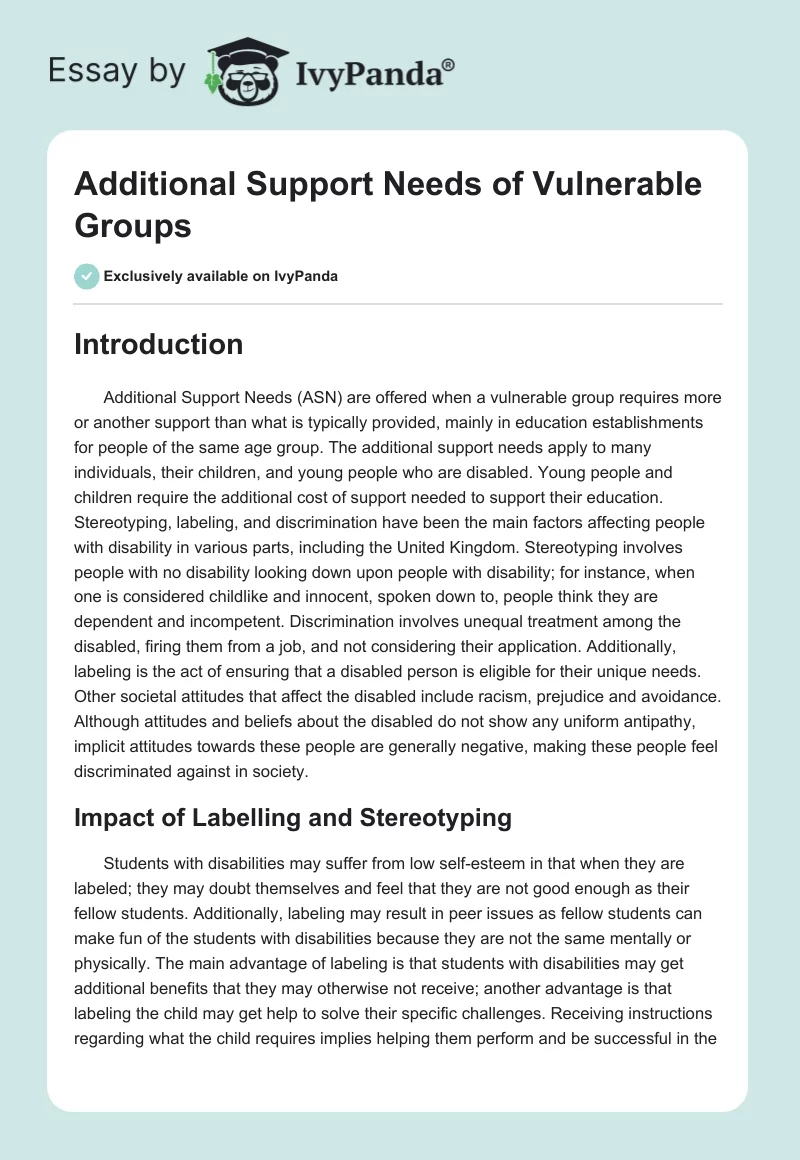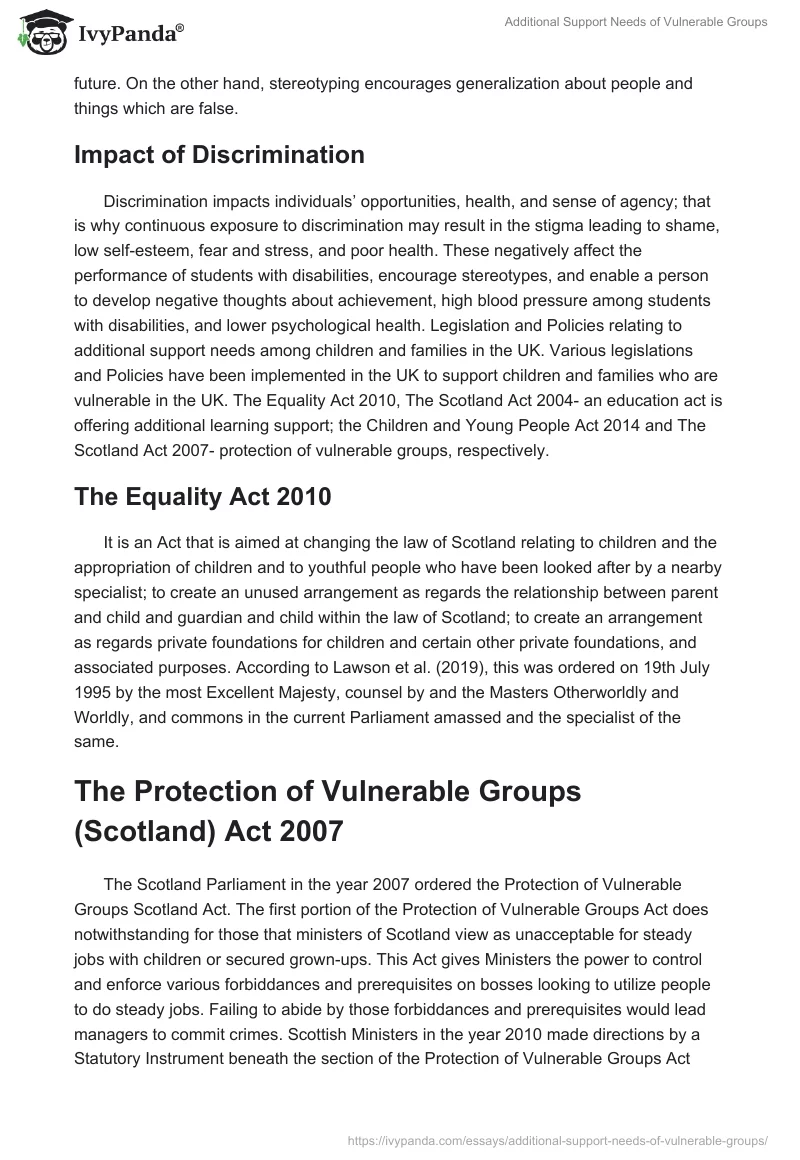Introduction
Additional Support Needs (ASN) are offered when a vulnerable group requires more or another support than what is typically provided, mainly in education establishments for people of the same age group. The additional support needs apply to many individuals, their children, and young people who are disabled. Young people and children require the additional cost of support needed to support their education. Stereotyping, labeling, and discrimination have been the main factors affecting people with disability in various parts, including the United Kingdom. Stereotyping involves people with no disability looking down upon people with disability; for instance, when one is considered childlike and innocent, spoken down to, people think they are dependent and incompetent. Discrimination involves unequal treatment among the disabled, firing them from a job, and not considering their application. Additionally, labeling is the act of ensuring that a disabled person is eligible for their unique needs. Other societal attitudes that affect the disabled include racism, prejudice and avoidance. Although attitudes and beliefs about the disabled do not show any uniform antipathy, implicit attitudes towards these people are generally negative, making these people feel discriminated against in society.
Impact of Labelling and Stereotyping
Students with disabilities may suffer from low self-esteem in that when they are labeled; they may doubt themselves and feel that they are not good enough as their fellow students. Additionally, labeling may result in peer issues as fellow students can make fun of the students with disabilities because they are not the same mentally or physically. The main advantage of labeling is that students with disabilities may get additional benefits that they may otherwise not receive; another advantage is that labeling the child may get help to solve their specific challenges. Receiving instructions regarding what the child requires implies helping them perform and be successful in the future. On the other hand, stereotyping encourages generalization about people and things which are false.
Impact of Discrimination
Discrimination impacts individuals’ opportunities, health, and sense of agency; that is why continuous exposure to discrimination may result in the stigma leading to shame, low self-esteem, fear and stress, and poor health. These negatively affect the performance of students with disabilities, encourage stereotypes, and enable a person to develop negative thoughts about achievement, high blood pressure among students with disabilities, and lower psychological health. Legislation and Policies relating to additional support needs among children and families in the UK. Various legislations and Policies have been implemented in the UK to support children and families who are vulnerable in the UK. The Equality Act 2010, The Scotland Act 2004- an education act is offering additional learning support; the Children and Young People Act 2014 and The Scotland Act 2007- protection of vulnerable groups, respectively.
The Equality Act 2010
It is an Act that is aimed at changing the law of Scotland relating to children and the appropriation of children and to youthful people who have been looked after by a nearby specialist; to create an unused arrangement as regards the relationship between parent and child and guardian and child within the law of Scotland; to create an arrangement as regards private foundations for children and certain other private foundations, and associated purposes. According to Lawson et al. (2019), this was ordered on 19th July 1995 by the most Excellent Majesty, counsel by and the Masters Otherworldly and Worldly, and commons in the current Parliament amassed and the specialist of the same.
The Protection of Vulnerable Groups (Scotland) Act 2007
The Scotland Parliament in the year 2007 ordered the Protection of Vulnerable Groups Scotland Act. The first portion of the Protection of Vulnerable Groups Act does notwithstanding for those that ministers of Scotland view as unacceptable for steady jobs with children or secured grown-ups. This Act gives Ministers the power to control and enforce various forbiddances and prerequisites on bosses looking to utilize people to do steady jobs. Failing to abide by those forbiddances and prerequisites would lead managers to commit crimes. Scottish Ministers in the year 2010 made directions by a Statutory Instrument beneath the section of the Protection of Vulnerable Groups Act 2007, Expulsion of Banished People away from Controlled job, Controls 2010. If an individual who is banned from directed work commits a criminal offense beneath segment 34 of the 2007 Act by looking for or doing directed work with the bunch, they are banished.
The impact of the 2010 Directions is that a manager commits a criminal offense if Scottish Priests have told them that the person is banished. The manager still grants that individual to proceed to work for the company and does not expel the individual from doing that directed task. The review checking started on 29th October 2012, and its completion was planned to be by 29 October 2015 (Babaian, 2018). A tremendous, more significant part of associations and managers in Scotland had brought significant individuals with experience into the Protection of Vulnerable Groups Plot. Be that as it may, a few associations had not accomplished the target. The main reason for the interview included the government of Scotland looking for the owner of associations, managers, and people to make decisions under new directions that ought to be made beneath the section of the act made in 2007 and reviewing its total arrangements to disavow and supplant the Regulations of 2010. At the beginning of this reviewing program, Priests made a sincere dedication to controlling unused forbiddances with necessities beneath sections 35(2) and (3) of the 2007 Act. The two would be counseled with partners earlier to draft directions being laid in Parliament; this commitment was satisfied by the interview.
Positive Aspects of Equality Act 2010 and Children’s 1995 Scotland Act
The Equality Act 2010 ensures individuals are segregated based on age, sex, race, religion, pregnancy, maternity, and vulnerable groups. They are the ensured features of equality. The act was implemented in Scotland and Britain in 2010 and was not ordered in Northern Ireland (Sharp, 2019). In any case, two laws advance the correspondence of chances for individuals with inabilities through forbidding incapacity segregation and therefore allow amendable lawful rights and policies to individuals with disabilities. This Act discourages discrimination in employment through; job application through which employment terms are offered during training, promotion, and equal terms in the company between the employer and the employees.
Negative Aspects of the Equality Act 2010 and Children’s 1995 Scotland Act
Age isolation is still permitted as long as it incorporates a true-blue motive, can only use two combined characteristics, a colossal law to raise mindfulness and incorporates a part of expensive costs attached. New laws do not have case law and few tall profile cases. Positive Aspects of Protection for the Vulnerable Groups in Scotland 2007 act on supporting children and families with additional support needs (Williams et al., 2020). The Protecting Vulnerable Groups (PVG) enrollment conspire overseen and conveyed by Divulgence Scotland. It makes a difference to guarantee individuals whose conduct makes them unacceptable to work with children and secure grown-ups cannot do ‘regulated work’ with these vulnerable groups.
Models of Disability
Three main models have been addressed to explain many types of disabilities. They provide references for the people, laws, regulations, and structures which affect people living with disabilities. The medical model describes disability as a result of a health condition or disease that affects the regular operation of a person’s physiological or cognitive (Retief and Letšosa, 2018). Additionally, the model refers to disability as a condition that one suffers from and has preventative measures and treatment for the disabling condition. The functional model refers to a disabled condition as the medical model because it states disability as an impairment or health condition. It states that disability is caused by physical or medical deficits that hinder the functional role of the disabled. Lastly, the social model focuses on the limitations of people with disabilities rather than the health conditions and impairments of those with a disability. The model emphasizes that the person’s activities are not influenced by the impairment but by the environment and barriers that result in a lack of social organization.
Panel Fair Approach
This approach involves the protection and prioritizing of human rights. It emphasizes ensuring that policies and practices are based on the rights of people. It is a tool to take human rights standards off the page and practice them daily. The Panel principles break down what human rights mean. It represents Participation, Accountability, Non- discrimination, Empowerment, and Legality. Participation is when every person has the right to participate and make their own decisions and it must be active and meaningful. While accountability involves monitoring people’s rights and how to correct them. Additionally, non-discrimination is the act of prioritizing the rights of people with challenges and ensuring that any discrimination is avoided. Empowerment entails involving people in making policies and laws affecting their daily lives and educated to understand their rights. Lastly, legality is the act of legalizing rights based on laws.
This approach challenges discrimination and promotes positive values for the following reasons; speaking up to the discriminatory person, which enables the person to know that the behavior is wrong and educate them accordingly, and having an equality and diversity policy which enables people to know what is acceptable and their consequences and finally reporting discrimination; the report should be seriously investigated according to polices and law.
Positive and Adverse Effects of Panel Fair Approach
Many people have been empowered to understand their rights through the Panel Fair Approach. Also, it has enabled people protecting rights to have power over discrimination, stereotyping and labeling. Some of the disadvantages occur when the people responsible for rights should work on changing people’s attitudes rather than formulating rules and policies. Additionally, educating people using various sources such as media and advertising to avoid stereotyping and the Panel Fair Approach is not easy to know how people are disobeying the rules and policies.
Conclusion
In conclusion, these societal attitudes, such as stereotyping, labeling and discrimination, should be avoided in vulnerable groups to promote peace among people and encourage development in various parts of the world, not only in the United Kingdom. Various legislation and policies should be well enacted to curb discrimination to get rid of these negative societal attitudes. The adverse effects of these laws should be minimized. I also urge countries across the world to use Panel Fair Approach as a way to protect human rights.
Reference List
Babaian, S., 2018. The International Criminal Court–An International Criminal World Court?: Jurisdiction and Cooperation Mechanisms of the Rome Statute and its Practical Implementation. Springer.
Lawson, L., McLean, F., O’Neill, R. and Wilks, R., 2019. Recognising British sign language in Scotland.The legal recognition of sign languages: Advocacy and outcomes around the world, pp.67-81.
Pritchard-Jones, L., 2018. “Adults at risk”:“vulnerability” by any other name?. The Journal of Adult Protection.
Retief, M. and Letšosa, R., 2018. Models of Disability: A Brief Overview.HTS Teologiese Studies/Theological Studies, 74(1).
Sharp, L., 2019. Effectiveness of Current Statutory Guidance Which Supports Part 3 of the Children and Young People (Scotland) Act 2014: Consultation Analysis.
Williams, F., Warwick, M., McKay, C., Macleod, C. and Connolly, M., 2020. Learning disability, autism and Criminal Procedure (Scotland) Act.Advances in Mental Health and Intellectual Disabilities.


